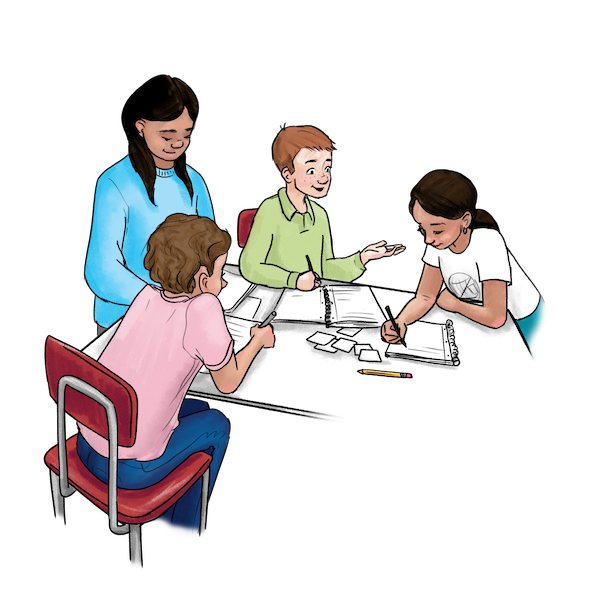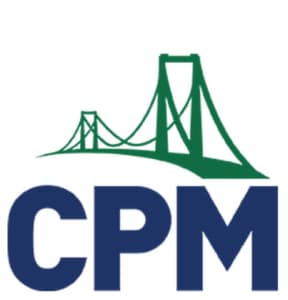May 2023

As CPM writes the new Inspiring Connections series, many conversations have focused on supporting students’ language development. Supporting students’ language development is an important equity issue, with many nuances to navigate in order to avoid perpetuating problematic ideas about students’ ability to learn mathematics.
In this article, the terms “English learner” and “multilingual learner” reflect the terms used in the referenced documents. This is walking a fine line between centering English and addressing the fact that English is the language of power in U.S. mathematics education. Pretending that CPM is linguistically neutral and its material is not inherently more or less accessible depending on students’ linguistic background is akin to colorblindness with regard to racial issues: it can create just as many problems as centering English, those problems are just subtler. Thus, this article gives explicit attention to the importance of home languages, not because they serve as a foundation for developing English or can be leveraged for accessing mathematical content, but because home languages are valuable and worthy of development in their own right, including in mathematics classes.
In California, a policy document, the English Learner Roadmap (California Department of Education, 2022), highlights several ways that mathematics teachers and curricula are responsible for supporting language development within U.S. mathematics classrooms.
- Element 2.A. Integrated and Designated English Language Development (ELD) Language development occurs in and through subject matter learning and is integrated across the curriculum
- Element 2.E. Use of Students’ Home Languages Students’ home language is understood as a means to access subject matter content, as a foundation for developing English, and, where possible, is developed to high levels of literacy and proficiency along with English.
- Element 2.F. Rigorous Instructional Material Rigorous instructional materials support high levels of intellectual engagement. Explicit scaffolding enables meaningful participation by English learners at different levels of English language proficiency. Integrated language development, content learning, and opportunities for bilingual/biliterate development are appropriate according to the program model.
This means that mathematics teachers are responsible for supporting students’ language development in and beyond English and leveraging students’ full linguistic repertoires as assets for developing deeper mathematical understandings.
Word Walls in Inspiring Connections One of the ways that CPM addresses these elements is through the purposeful implementation of word walls. Throughout the Inspiring Connections series, you will see references to word walls, such as the following.
Collect and Display the terms students use to describe the data distribution, such as “symmetric,” “skewed,” “mean,” “median,” “range,” and “outlier.” Consider adding these terms to your class word wall. Throughout the course, new mathematical vocabulary terms will be bolded in the student text. Consider adding these words and other vocabulary words (both mathematical and non-mathematical) to your class word wall. There are many ways to develop and incorporate word walls. Use a model that works for your students and leverages language as an asset. Encourage students to draw on their home languages by using student-friendly and student created definitions, drawings, and multilingual connections. Include terms students ask about regularly and that they would benefit from having available in their language repertoire during activities that involve speaking and writing.
(Inspiring Connections Course 3, Lesson 1.1.1)
Word walls should be student-generated, visually appealing, legible from across the room, and use realia ( Jackson & Narvaez, 2013). In Inspiring Connections, word walls are a dynamic, multilingual reference that students co-develop throughout each unit.
When identifying terms to recommend for teachers’ word walls, CPM drew upon Beck et al.’s (2013) tiered framing of vocabulary.
- Tier 1 words are basic words that students who are proficient in English typically know (e.g., rollercoaster, population, thermometer).
- Tier 2 words are those that are often used in classrooms and extend beyond one particular subject area (e.g., simulate, estimate, justify).
- Tier 3 words are highly specific for each content area and are housed within a particular subject (e.g., scatter plot, coordinate plane, expression).
Each Lesson at a Glance in Inspiring Connections provides teachers with Tier 3 words that are incorporated in the lesson either as student-facing terms or terms which arise during the facilitation or discussion of specific problems. While the lessons call attention to specific terms to add to the class word wall, teachers will also consider when to add additional student produced terms. Within each lesson is support for tiered words, including ways to incorporate students’ home languages to support them in accessing the mathematical content and in their holistic language development. For example, coinciding with a problem with a gardening experiment, the Authors’ Vision outlines suggestions for supporting students’ language development.
After teams have read the problem, ask students to share what the word “fertilizer” means and encourage them to use their full linguistic repertoire as they discuss. Consider showing an image of a bag of fertilizer similar to those sold at gardening and home improvement stores, as providing realia can help students make sense of the class gardening experiment in the problem. (Inspiring Connections Course 3, Lesson 1.1.5)
Parting Thoughts
Word walls should be dynamic and co-developed with your students. They should provide visual representations of vocabulary (Carr et al., 2007) and include critical vocabulary from all three tiers of Beck et al.’s (2013) model. The vocabulary and examples displayed on your word wall should reflect your students’ languages, dialects, and cultures. Language and vocabulary are crucial to literacy and academic success (Nagy & Townsend, 2012), among multilingual learners in particular (Shanahan & Beck, 2006; Snow, 2009).
Word walls should be easily accessible to students in your physical classroom space in order to have an impact on language development. Encourage students to stand up or move closer to the word wall when crafting mathematical arguments orally or in writing, and to gesture at the wall when discussing problems with team members. You may also encourage students to take pictures or copy down the word wall into their Mathematician’s Notebook at various stages in a lesson, section, or chapter, as having access to the vocabulary outside of your classroom is valuable.
As you continue to reflect on how to support your students’ vocabulary development, consider the Learning for Justice Vocabulary Selection Planner. To access the Inspiring Connections demo curriculum, contact your Regional Professional Learning Coordinator.
Editor’s Note: The original version of this article included a brief mention that, in addition to supporting multilingual learners, word walls can benefit “students with identified exceptionalities” (SWEs) as well. For instance, the Virginia Department of Education (2022) shares that word walls provide visual cues for students, which can be especially helpful for some SWEs’ mathematical vocabulary development. This has been moved to an endnote because the language development needs of students learning English as an additional language and the needs of students with language development-related disabilities are different, although word walls do appear to help both types of learners. The prevalence of misdiagnosing students who are learning English as having learning disabilities leads to a significant overrepresentation of English learners in special education services and thus to inequitable learning outcomes (National Center for Learning Disabilities, 2020), and so the CPM Newsletter Editorial Team found this worthy of note.
References
Beck, I. L., McKeown, M. G., & Kucan, L. (2013). Bringing words to life: Robust vocabulary instruction. Guilford Press.
California Department of Education. (2022). English learner roadmap. https://www.cde.ca.gov/sp/el/rm/
Carr, J., Sexton, U., & Lagunoff, R. (2007). Making science accessible to English learners: A guide for teachers. WestEd.
Jackson, J., & Narvaez, R. (2013). Interactive word walls: Create a tool to increase science vocabulary in five easy steps. Science and Children, 51(1), 42-49. https://www.bhamcityschools.org/cms/lib5/AL01001646/Centricity/Domain/131/Interactive%20Word%20Wall.pdf
Learning for Justice. (2013). Vocabulary selection planner. https://www.learningforjustice.org/sites/default/files/2017-07/6-12WW_Vocabulary%20Selection%20Planner.pdf
Nagy, W., & Townsend, D. (2012). Words as tools: Learning academic vocabulary as language acquisition. Reading Research Quarterly, 47(1), 91–108. https://doi.org/10.1002/RRQ.011
National Center for Learning Disabilities. (2020). Significant Disproportionality in Special Education: Trends Among English Learners (ELs). https://www.ncld.org/wp-content/uploads/2020/10/2020-NCLD-Disproportionality_-English-Learners_EL_FINAL.pdf
Virginia Department of Education. (2022). Mathematics vocabulary word wall cards. https://www.doe.virginia.gov/teaching-learning-assessment/k-12-standards-instruction/mathematics/instructional-resources/mathematics-vocabulary-word-wall-cards

Jillian Mendoza & Michael Lolkus
Jillian Mendoza, San Diego, CA, JillianMendoza@cpm.org
Michael Lolkus, Wilmington, DE, MikeLolkus@cpm.org

